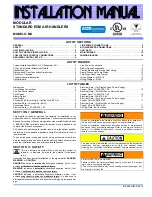
CLCH-SVX014B-EN
19
Start-Up — Indirect Gas-Fired Heating
Notes:
1.
This furnace module does not have a pilot. It is
equipped with a direct spark ignition device that
automatically lights the gas burner. DO NOT try to light
burners by hand.
2. BEFORE OPERATING, leak test all gas piping up to
heater gas valve. Smell around the unit area for gas. If
gas is smelled, do NOT attempt to place heater in
operation until source of gas leak is identified and
corrected.
3. Use only hand force to operate the gas control lever to
the “ON” position. NEVER use tools. If lever does not
operate by hand, replace gas valve prior to staring the
unit. Forcing or attempting to repair the gas valve may
result in fire or explosion.
4. Do not attempt to operate unit, if there is indication that
any part or control has been under water. Any control
or component that has been under water must be
replaced prior to trying to start the unit.
Gas Heat Application Rules — Inshot
•
The maximum allowable temperature rise is as listed
in table for minimum cfm.
•
Nominal airflow is based on 500 fpm through a
nominal coil (i.e. 500 x unit size 8 = 4000 cfm).
•
The minimum allowable airflow at full fire is 75 percent
of the nominal airflow (i.e. 0.75 x 500 x unit size 8 =
3000 cfm).
•
The minimum allowable airflow at reduced fire is 50
percent of the nominal airflow (i.e. 0.50 x 500 x unit size
8 = 2000 cfm).
•
Calculate temperature rise at airflows other than
nominal with this equation: Temp Rise = (1000 x MBh)
/ (1.1 x CFM)
•
On high altitude applications, derate the heating
capacity (MBh) by 4 percent for every 1,000 feet of
altitude over 2,000 feet above sea level.
•
Temperature rise is listed for nominal cfm/minimum
cfm.
Start-up Procedure
1.
Check Inlet Gas Pressure:
Ensure the gas pressure supplied to the unit is within
the pressure requirement listed on the nameplate. DO
NOT expose gas controls to pressures above 13 in. wc).
If required by local code, a field provided gas supply
line should be installed with a field provided external
manual shutoff and pressure tap.
2. Verify Fan Failure Switch Operation:
The supply fan air proving switch is located in the
heater electrical control compartment near the top of
the heater panel. The switch will fail if not proven
within 30 seconds of call for indoor fan—ON. All unit
air filters must be clean before proceeding to properly
complete this verification.
Important:
If the unit air filters are not clean, unit
performance could be affected. Remove
and clean or replace air filters as required
prior to proceeding with the burner
pressure testing.
WARNING
Hazardous Service Procedures!
Failure to follow all precautions in this manual and on
the tags, stickers, and labels could result in death or
serious injury.
•
Technicians, in order to protect themselves from
potential electrical, mechanical, and chemical
hazards, MUST follow precautions in this manual and
on the tags, stickers, and labels, as well as the
following instructions: Unless specified otherwise,
disconnect all electrical power including remote
disconnect and discharge all energy storing devices
such as capacitors before servicing. Follow proper
lockout/tagout procedures to ensure the power can
not be inadvertently energized. When necessary to
work with live electrical components, have a
qualified licensed electrician or other individual who
has been trained in handling live electrical
components perform these tasks.
•
Do not attempt the following procedures until all
electrical and gas connections to the unit have been
completed and the outdoor air damper and
evaporator fan operation have been verified and are
operating correctly.
WARNING
Hazard of Explosion!
Failure to follow proper safe leak test procedures could
result in death or serious injury or equipment or
property-only-damage. NEVER use an open flame to
detect gas leaks. You MUST use a leak test solution for
leak testing.
WARNING
Hazardous Voltage and Gas!
Failure to turn off gas or disconnect power before
servicing could result in an explosion or electrocution
which could result in death or serious injury. Turn off
the gas supply and disconnect all electric power,
including remote disconnects, before servicing the unit.
Follow proper lockout/tagout procedures to ensure the
power can not be inadvertently energized.
Содержание CSA004
Страница 24: ...24 CLCH SVX014B EN Wiring Diagrams Figure 12 Typical wiring diagram for 5 1 turndown heater ...
Страница 25: ...Wiring Diagrams CLCH SVX014B EN 25 Figure 13 Typical wiring diagram for 10 1 turndown heater ...
Страница 26: ...Wiring Diagrams 26 CLCH SVX014B EN Figure 14 Typical wiring diagram for 20 1 turndown heater ...










































